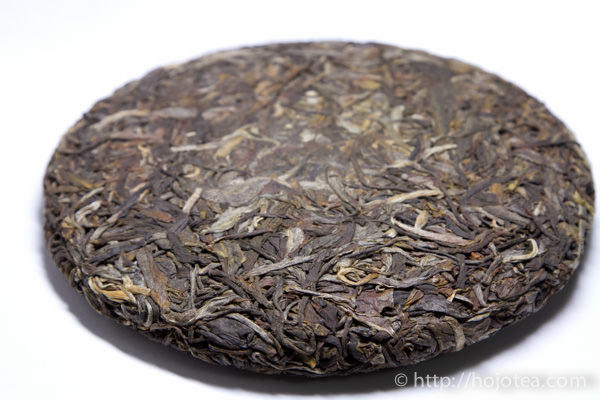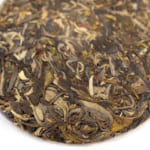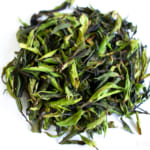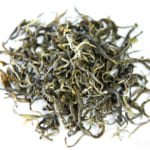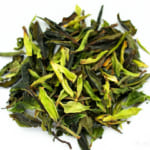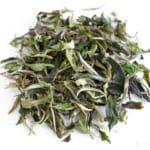- HOME >
- How to enjoy tea
Why is Pu-erh Tea Compressed?
Why are Pu-erh teas compressed? A common answer to this question would be to minimize volume and make transportation easier. However, there is another lesser-known reason.
No oxygen is an ideal environment for maturing Pu-erh tea
I conducted an experiment to observe the maturation process of Pu-erh tea under different storage conditions. I analyzed the tea after storing it in various environments: some were exposed to ambient air, some were vacuum-sealed, and some used an oxygen absorber to remove 100% of the oxygen. The tea stored without oxygen matured in the most ideal way.
The Pu-erh tea stored in the ambient atmosphere developed an unpleasant musty odor due to aggressive oxidation. In contrast, the Pu-erh tea stored without oxygen developed a sweet flavor reminiscent of honey and produced a sweet, fruity, or sugarcane-like taste with further aging.
Based on these findings, I have concluded that keeping Pu-erh tea in an oxygen-free environment is essential for achieving optimal maturation.
The maturation is different from fermentation
Some people insist that the maturation of Pu-erh tea is a process of “fermentation.” However, I completely disagree with this idea. Fermentation refers to a chemical reaction mediated by enzymes, but Pu-erh tea that is vacuum-packed contains very low moisture, which is insufficient for any enzymatic reaction to occur. Of course, if tea is stored in a room with high humidity, it will quickly become contaminated by microorganisms such as mold and bacteria. Even assuming there is no microbial contamination, improperly stored Pu-erh teas can develop musty or earthy flavors if oxidation occurs in an uncontrolled manner.
The maturation of tea involves no enzyme and no microorganism
Maturation of tea involves a non-enzymatic oxidation and reduction process that alters the constituents in the tea leaves. When tea is exposed to the oxygen in the atmosphere, it triggers excessive oxidation, which leads to the tea becoming oxidized and spoiled. Therefore, an ideal environment for tea maturation is one without oxygen. One might wonder, then, how the tea can mature or oxidize when there is no oxygen. In chemistry, there are three definitions for oxidation, which are as follows:
- Receive Oxygen
- Release Hydrogen
- Release Electron
As you can see from the above three definitions, we do not actually need the oxygen in the air to carry out the maturation (oxidation) process. If you wish to learn more about the definition of oxidation, please refer to the following page:http://www.chemguide.co.uk/inorganic/redox/definitions.html
Both compression and suction can remove oxygen
Let’s rewind to the reason why we need to compress Pu-erh tea. Usually, if one wishes to completely remove the oxygen in the tea leaves, it is either vacuum-sealed or compressed very hard. Both compression and suction can eliminate oxygen if the pressure is strong enough. Most Pu-erh tea manufacturing locations in Yunnan are deep in the mountains, where it can sometimes take more than 20 hours by local bus from Kunming to reach the destination. The practice of compressing tea originates from the wise ancient Yunnan people, who wanted to ensure that oxygen was completely eliminated from the tea. Additionally, the compressed tea made transportation more convenient. Although the leaves at the surface of the Pu-erh cake will inevitably be oxidized, the volume of the tea leaves on the external layer of the cake is considered very minor and negligible.
The Pu-erh tea cake used to be compressed very hard
About 20-30 years ago, the Pu-erh tea was often compressed extremely hard that it was known as the “iron bing” (铁饼). It was compressed as hard as a piece of stone that one cannot even break it using a knife or a strong eyeleteer. Based on my experience, all the iron bing Pu-erh tea was ideally matured no matter how it was kept. Thanks to the hard compression, there was no oxygen remaining inside the leaves. These teas produced sweet flavour like dried fruits which I enjoy drinking them so much. Unfortunately, nowadays most of Pu-erh teas are not compressed like an iron bing anymore. If we compress our tea too hard, we would receive a number of complaints from the customer saying that it is really very hard to break apart the tea for drinking. Generally, nowadays most of tea companies compress Pu-erh tea moderately, which will definitely leave some oxygen in the tea leaves. Under the circumstances, tea will get oxidized no matter how it is kept.
Based on the above logic, we pack tea with an oxygen absorber that is made of the reduction iron powder. This will absorb oxygen as iron absorbs the oxygen from the atmosphere to form iron oxide. We are quite satisfied by this method since we can get the tea well-matured in a right environment and at the same time, the Pu-erh tea cake will not be too hard to cause nuisance to the customers.
Related Articles
How to get the latest update on HOJO?
1. Follow Twitter, 2. Click "Like" on Facebook, and 3. Subscribe in newsletter. You can have the latest tea news from HOJO.
 Subscribe the Newsletter to enjoy the privileges
Subscribe the Newsletter to enjoy the privileges- You may receive a free sample upon purchase, or you may have the priority to purchase special products. So please remember to subscribe our newsletter as well as the social network.
- Myanmar White Tea Bud 2013 from Guo Gan, Myanmar
- We have released a raw Pu-erh tea, 緬甸白芽茶 2013 (Myanmar White Tea Bud 2013), produced by ethnic minorities in t …
- Yong De Wild White Tea 2025 Loose Leaf Limited Release
- We have released Yong De Wild White Tea Loose 2025. For the 2025 harvest, only the loose-leaf type was …
NEW ARTICLES
 Myanmar White Tea Bud 2013 from Guo Gan, Myanmar
Myanmar White Tea Bud 2013 from Guo Gan, Myanmar- We have released a raw Pu-erh tea, 緬甸白芽茶 2013 (Myanmar White Tea Bud 2013), produced by ethnic minorities in t …
 Yong De Wild White Tea 2025 Loose Leaf Limited Release
Yong De Wild White Tea 2025 Loose Leaf Limited Release- We have released Yong De Wild White Tea Loose 2025. For the 2025 harvest, only the loose-leaf type was …
 Experience the True Freshness of Raw Pu-erh : Tang Jia 2025 Loose Leaf Release
Experience the True Freshness of Raw Pu-erh : Tang Jia 2025 Loose Leaf Release- We have released Tang Jia Raw Pu-erh Tea 唐家古樹生茶 2025 Loose Leaf. Among HOJO’s raw pu-erh teas, Tang Jia Raw Pu …
 Yunnan Chun Jian Green Tea from High Mountain Gardens
Yunnan Chun Jian Green Tea from High Mountain Gardens- Yunnan Chun Jian Green Tea is now available. This tea is made from naturally grown leaves harvested from high …
 Limited Loose Leaf Release of 2025 Da Xue Shan Wild Raw Pu-erh Tea
Limited Loose Leaf Release of 2025 Da Xue Shan Wild Raw Pu-erh Tea- We have released the 2025 loose-leaf version of Da Xue Shan Wild Raw Pu-erh Tea. This tea comes from wild tea …
 Discover a New Way to Enjoy Tea: Cooking Rice with Tea
Discover a New Way to Enjoy Tea: Cooking Rice with Tea- Cooking rice with tea is a simple idea, but it brings surprisingly satisfying results. The tea’s flavour seeps …
 2025 Da Xue Shan Wild White Tea Now Available from Yunnan
2025 Da Xue Shan Wild White Tea Now Available from Yunnan- The 2025 harvest of Da Xue Shan Wild White Tea is now available. Crafted from truly wild Camellia taliensis tr …
 Fresh 2025 Yunnan White Tea – Select Your Favourite Lot Before Blending
Fresh 2025 Yunnan White Tea – Select Your Favourite Lot Before Blending- Freshly crafted in Yunnan and just arrived in KL, our new 2025 white tea is now available at our Gardens Mall …
 2024 Dong Shan Raw Pu-erh Tea – Crafted with the Producer for Desired Quality
2024 Dong Shan Raw Pu-erh Tea – Crafted with the Producer for Desired Quality- We have released the 2024 cake of Dong Shan Raw Pu-erh Tea. Earlier, we offered the loose-leaf version from th …
 Development of Firewood Roasted Hojicha Using Naturally Grown Tea from Yunnan
Development of Firewood Roasted Hojicha Using Naturally Grown Tea from Yunnan- We are currently staying in Yunnan Province for tea production. As the season nears its end, tea trees with pa …
Category
- New Arrival at HOJO Online Shop
- Featured Articles
- Newsletter
- Types of Tea
- Origin of Tea
- Teapot and Tea Equipment
- Tea Column
- How to enjoy tea
- Tea Processing
- How to choose quality tea
- Tea constituents and functional effect
- Safety of Tea
- Foods
- Tea Business Operation
- Hobby and Outdoor Activity
- Ranking of Tea
- Video
- FAQ
- Media Release
Profile

- AKIRA HOJO
- I invite you to experience my tea selections.I was born in Nagano, Japan. In university, I studied agricultural chemistry, and I have the master degree in food science. I worked in Japanese food industry for 10 years. I involved in R&D, QC and QA. As a factory manager, I implemented ISO9000 series and managed the factory.
- The Art of Tea Magazine
- We posted the article on “The Art of Tea Magazine No.9, the magazine is published in Taiwan. We featured …
- New Straits Times
- The Malaysian National Newspaper, New Straits Times featured HOJO Tea on 17-Oct-2007.
Shop Info

Address:Lot No. T-215, 3rd Floor, The Gardens Mall, Mid Valley City, Lingkaran Syed Putra, 59200 Kuala Lumpur
Tel: +603-2287-4537
Business Hour: 10am to 10pm


